Comparison of Accuracy of Surface Temperature Images from Unmanned Aerial Vehicle and Satellite for Precise Thermal Environment Monitoring of Urban Parks Using In Situ Data
Abstract
1. Introduction
2. Materials and Methods
2.1. Study Area
2.2. Acquisition of UAV TIR LST Data
2.3. Landsat 8 LST
2.4. Measurement of In Situ LST
2.5. Accuracy Verification of UAV TIR LST and Landsat 8 TIR LST
3. Results
3.1. UAV TIR LST Data
3.2. Landsat 8 TIR LST
3.3. Measurement of In Situ LST
3.4. Evaluation of Accuracy of TIR LSTs of UAV and Landsat 8
3.4.1. Linear Regression Analysis Result
3.4.2. Differences in UAV TIR LST and Landsat 8 TIR LST Based on In Situ LST
3.4.3. RMSE Analysis Result
4. Discussion
5. Conclusions
Author Contributions
Funding
Data Availability Statement
Conflicts of Interest
References
- United Nations, Department of Economic and Social Affairs. Population Division. World Urbanization Prospects: The 2018 Revision (ST/ESA/SER.A/420); United Nations: New York, NY, USA, 2019. [Google Scholar]
- The World Bank Group. 2019. Available online: https://data.worldbank.org/indicator/sp.urb.totl.in.zs (accessed on 10 January 2020).
- Cumming, G.S.; Buerkert, A.; Hoffmann, E.M.; Schlecht, E.; von Cramon-Taubadel, S.; Tscharntke, T. Implications of agricultural transitions and urbanization for ecosystem services. Nature 2014, 515, 50–57. [Google Scholar] [CrossRef] [PubMed]
- Qiu, K.; Jia, B. The roles of landscape both inside the park and the surroundings in park cooling effect. Sustain. Cities Soc. 2020, 52, 101864. [Google Scholar] [CrossRef]
- Qiao, Z.; Liu, L.; Qin, Y.; Xu, X.; Wang, B.; Liu, Z. The impact of urban renewal on land surface temperature changes: A case study in the main city of Guangzhou, China. Remote Sens. 2020, 12, 794. [Google Scholar] [CrossRef]
- Howard, L. The Climate of London: Deduced from Meteorological Observations, Made at Different Places in the Neighbourhood of the Metropolis; W. Phillips: Cambridge, MA, USA, 1820; Volume 1. [Google Scholar]
- Yu, Z.; Yang, G.; Zuo, S.; Jørgensen, G.; Koga, M.; Vejre, H. Critical review on the cooling effect of urban blue-green space: A threshold-size perspective. Urban For. Urban Green. 2020, 49, 126630. [Google Scholar] [CrossRef]
- Carvalho, D.; Martins, H.; Marta-Almeida, M.; Rocha, A.; Borrego, C.J.U.C. Urban resilience to future urban heat waves under a climate change scenario: A case study for Porto urban area (Portugal). Urban Clim. 2017, 19, 1–27. [Google Scholar] [CrossRef]
- Jaganmohan, M.; Knapp, S.; Buchmann, C.M.; Schwarz, N. The bigger, the better? The influence of urban green space design on cooling effects for residential areas. J. Environ. Qual. 2016, 45, 134–145. [Google Scholar] [CrossRef]
- Yang, C.; He, X.; Yu, L.; Yang, J.; Yan, F.; Bu, K.; Chang, L.; Zhang, S. The cooling effect of urban parks and its monthly variations in a snow climate city. Remote Sens. 2017, 9, 1066. [Google Scholar] [CrossRef]
- Yang, A.S.; Juan, Y.H.; Wen, C.Y.; Chang, C.J. Numerical simulation of cooling effect of vegetation enhancement in a subtropical urban park. Appl. Energy 2017, 192, 178–200. [Google Scholar] [CrossRef]
- Pandey, P.; Kumar, D.; Prakash, A.; Masih, J.; Singh, M.; Kumar, S.; Jain, V.K.; Kumar, K. A study of urban heat island and its association with particulate matter during winter months over Delhi. Sci. Total Environ. 2012, 414, 494–507. [Google Scholar] [CrossRef]
- Lazzarini, M.; Marpu, P.R.; Ghedira, H. Temperature-land cover interactions: The inversion of urban heat island phenomenon in desert city areas. Remote Sens. Environ. 2013, 130, 136–152. [Google Scholar] [CrossRef]
- Naughton, J.; McDonald, W. Evaluating the variability of urban land surface temperatures using drone observations. Remote Sens. 2019, 11, 1722. [Google Scholar] [CrossRef]
- Webster, C.; Westoby, M.; Rutter, N.; Jonas, T. Three-dimensional thermal characterization of forest canopies using UAV photogrammetry. Remote Sens. Environ. 2018, 209, 835–847. [Google Scholar] [CrossRef]
- Di Felice, F.; Mazzini, A.; Di Stefano, G.; Romeo, G. Drone high resolution infrared imaging of the Lusi mud eruption. Mar. Pet. Geol. 2018, 90, 38–51. [Google Scholar] [CrossRef]
- Kelly, J.; Kljun, N.; Olsson, P.O.; Mihai, L.; Liljeblad, B.; Weslien, P.; Klemedtsson, L.; Eklundh, L. Challenges and best practices for deriving temperature data from an uncalibrated UAV thermal infrared camera. Remote Sens. 2019, 11, 567. [Google Scholar] [CrossRef]
- Song, B.; Park, K. Verification of Accuracy of Unmanned Aerial Vehicle (UAV) Land Surface Temperature Images Using In-Situ Data. Remote Sens. 2020, 12, 288. [Google Scholar] [CrossRef]
- Acorsi, M.G.; Gimenez, L.M.; Martello, M. Assessing the Performance of a Low-Cost Thermal Camera in Proximal and Aerial Conditions. Remote Sens. 2020, 12, 3591. [Google Scholar] [CrossRef]
- Dronova, I.; Friedman, M.; McRae, I.; Kong, F.; Yin, H. Spatio temporal non-uniformity of urban park greenness and thermal characteristics in a semi-arid region. Urban For. Urban Green. 2018, 34, 44–54. [Google Scholar] [CrossRef]
- Lafortezza, R.; Carrus, G.; Sanesi, G.; Davies, C. Benefits and well-being perceived by people visiting green spaces in periods of heat stress. Urban For. Urban Green. 2009, 8, 97–108. [Google Scholar] [CrossRef]
- Nastran, M.; Kobal, M.; Eler, K. Urban heat islands in relation to green land use in European cities. Urban For. Urban Green. 2019, 37, 33–41. [Google Scholar] [CrossRef]
- Hong, S.; Lee, Y.W.; Ryu, J.H.; Yeom, J.M.; Kim, W.; Cho, J. Satellite-based assessment of rapid mega-urban development on agricultural land. J. Agric. Meteorol. 2018, 74, 87–91. [Google Scholar] [CrossRef]
- Yang, Y.; Lee, X. Four-band thermal mosaicking: A new method to process infrared thermal imagery of urban landscapes from UAV flights. Remote Sens. 2019, 11, 1365. [Google Scholar] [CrossRef]
- Lillesand, T.; Kiefer, R.W.; Chipman, J. Remote Sensing and Image Interpretation, 6th ed.; John Wiley & Sons: New York, NY, USA, 2015. [Google Scholar]
- Ortiz-Sanz, J.; Gil-Docampo, M.; Arza-García, M.; Cañas-Guerrero, I. IR Thermography from UAVs to Monitor Thermal Anomalies in the Envelopes of Traditional Wine Cellars: Field Test. Remote Sens. 2019, 11, 1424. [Google Scholar] [CrossRef]
- USGS. Landsat 8 (L8) Data Users Handbook (LSDS-1574, Version 3.0); EROS: Sioux Falls, SD, USA, 2018.
- Jiménez-Muñoz, J.C.; Cristóbal, J.; Sobrino, J.A.; Sòria, G.; Ninyerola, M.; Pons, X. Revision of the single-channel algorithm for land surface temperature retrieval from Landsat thermal-infrared data. IEEE Trans. Geosci. Remote Sens. 2008, 47, 339–349. [Google Scholar] [CrossRef]
- Qin, Z.; Karnieli, A.; Berliner, P. A mono-window algorithm for retrieving land surface temperature from Landsat TM data and its application to the Israel-Egypt border region. Int. J. Remote Sens. 2001, 22, 3719–3746. [Google Scholar] [CrossRef]
- Sekertekin, A.; Bonafoni, S. Sensitivity Analysis and Validation of Daytime and Nighttime Land Surface Temperature Retrievals from Landsat 8 Using Different Algorithms and Emissivity Models. Remote Sens. 2020, 12, 2776. [Google Scholar] [CrossRef]
- Sobrino, J.A.; Jiménez-Muñoz, J.C.; Sòria, G.; Romaguera, M.; Guanter, L.; Moreno, J.; Plaza, A.; Martínez, P. Land surface emissivity retrieval from different VNIR and TIR sensors. IEEE Trans. Geosci. Remote Sens. 2008, 46, 316–327. [Google Scholar] [CrossRef]
- Masina, M.; Lambertini, A.; Daprà, I.; Mandanici, E.; Lamberti, A. Remote Sensing Analysis of Surface Temperature from Heterogeneous Data in a Maize Field and Related Water Stress. Remote Sens. 2020, 12, 2506. [Google Scholar] [CrossRef]
- Malbéteau, Y.; Parkes, S.; Aragon, B.; Rosas, J.; McCabe, M.F. Capturing the diurnal cycle of land surface temperature using an unmanned aerial vehicle. Remote Sens. 2018, 10, 1407. [Google Scholar] [CrossRef]
- Kraaijenbrink, P.D.; Shea, J.M.; Litt, M.; Steiner, J.F.; Treichler, D.; Koch, I.; Immerzeel, W.W. Mapping surface temperatures on a debris-covered glacier with an unmanned aerial vehicle. Front. Earth Sci. 2018, 6, 64. [Google Scholar] [CrossRef]
- Smigaj, M.; Gaulton, R.; Suarez, J.C.; Barr, S.L. Use of miniature thermal cameras for detection of physiological stress in conifers. Remote Sens. 2017, 9, 957. [Google Scholar] [CrossRef]
- Sheng, H.; Chao, H.; Coopmans, C.; Han, J.; McKee, M.; Chen, Y. Low-cost UAV-based thermal infrared remote sensing: Platform, calibration and applications. In Proceedings of the 2010 IEEE/ASME International Conference on Mechatronic and Embedded Systems and Applications, QingDao, China, 15–17 July 2010; pp. 38–43. [Google Scholar]
- Pour, T.; Miřijovský, J.; Purket, T. Airborne thermal remote sensing: The case of the city of Olomouc, Czech Republic. Eur. J. Remote Sens. 2019, 52 (Suppl. 1), 209–218. [Google Scholar] [CrossRef]
- Ribeiro-Gomes, K.; Hernández-López, D.; Ortega, J.F.; Ballesteros, R.; Poblete, T.; Moreno, M.A. Uncooled thermal camera calibration and optimization of the photogrammetry process for UAV applications in agriculture. Sensors 2017, 17, 2173. [Google Scholar] [CrossRef]
- Hamada, S.; Ohta, T. Seasonal variations in the cooling effect of urban green areas on surrounding urban areas. Urban For. Urban Green. 2010, 9, 15–24. [Google Scholar] [CrossRef]
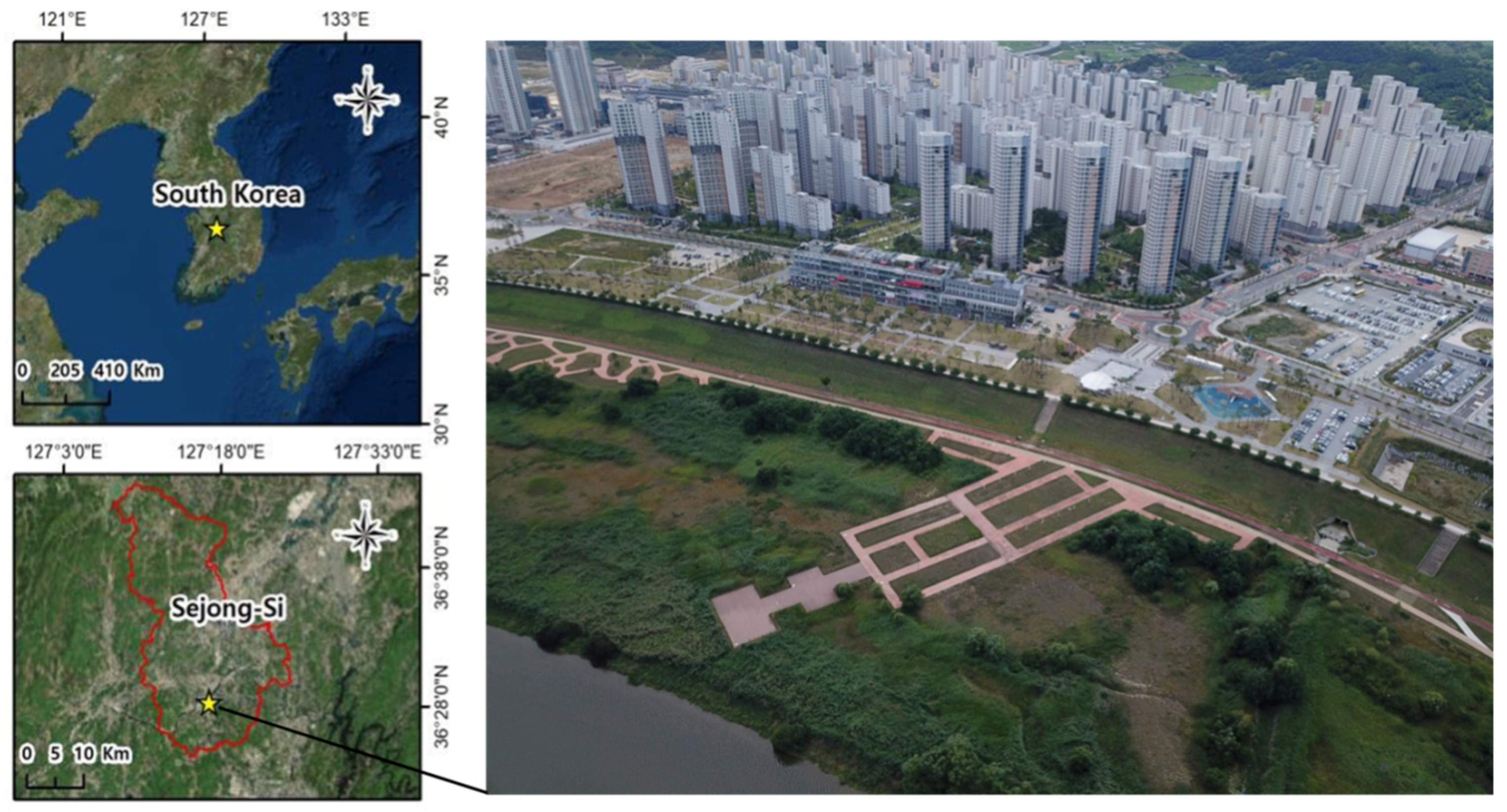
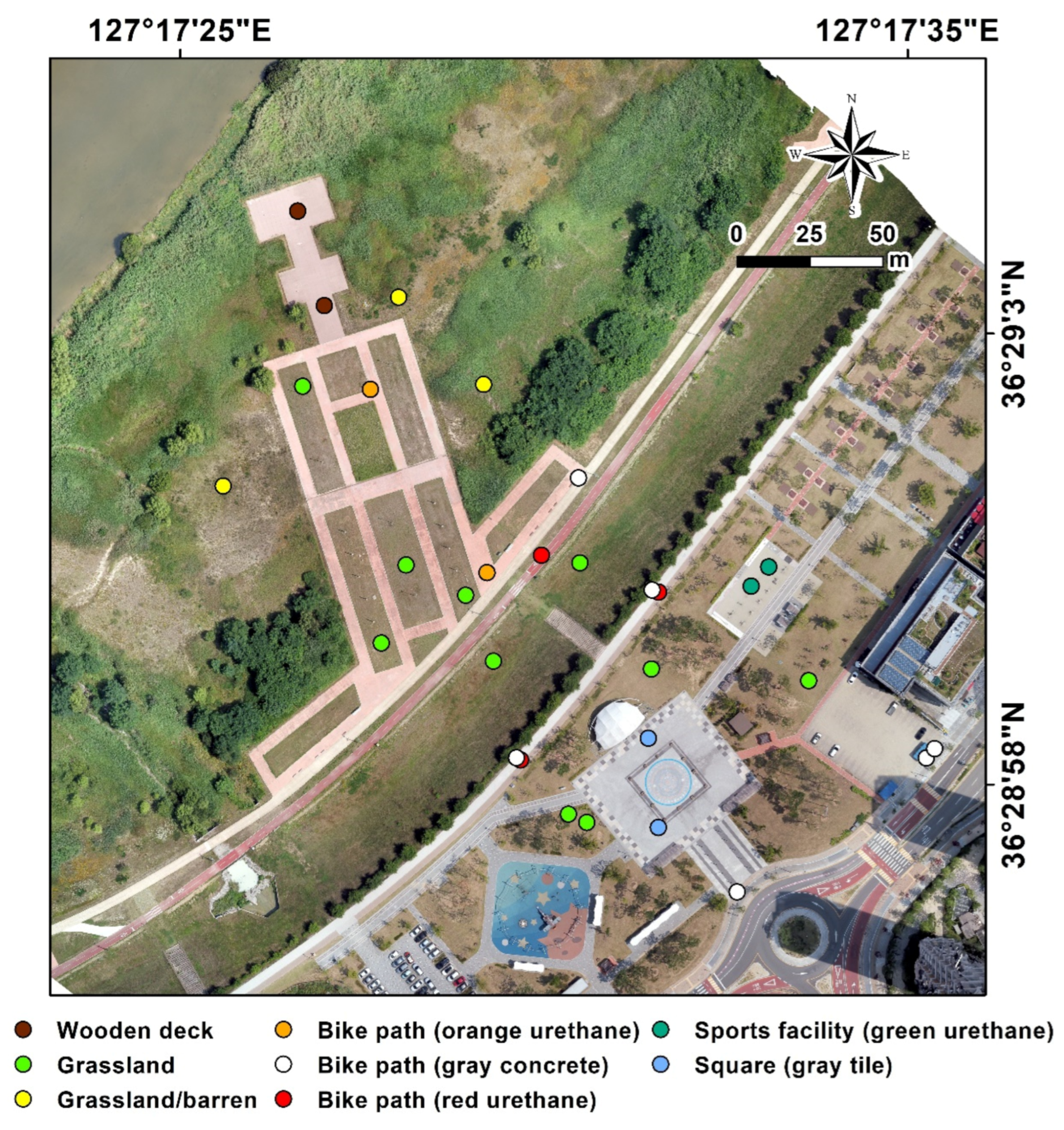
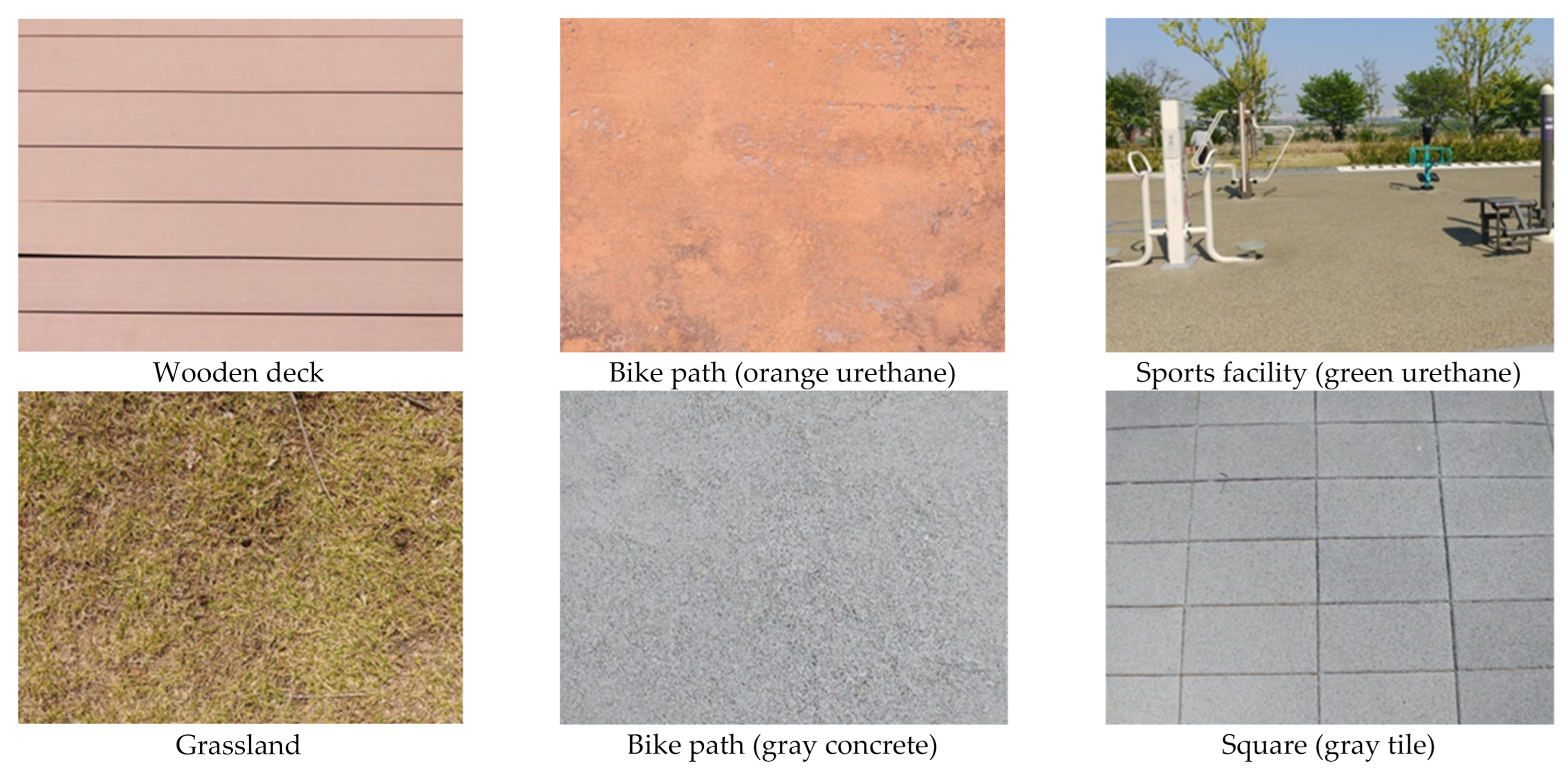
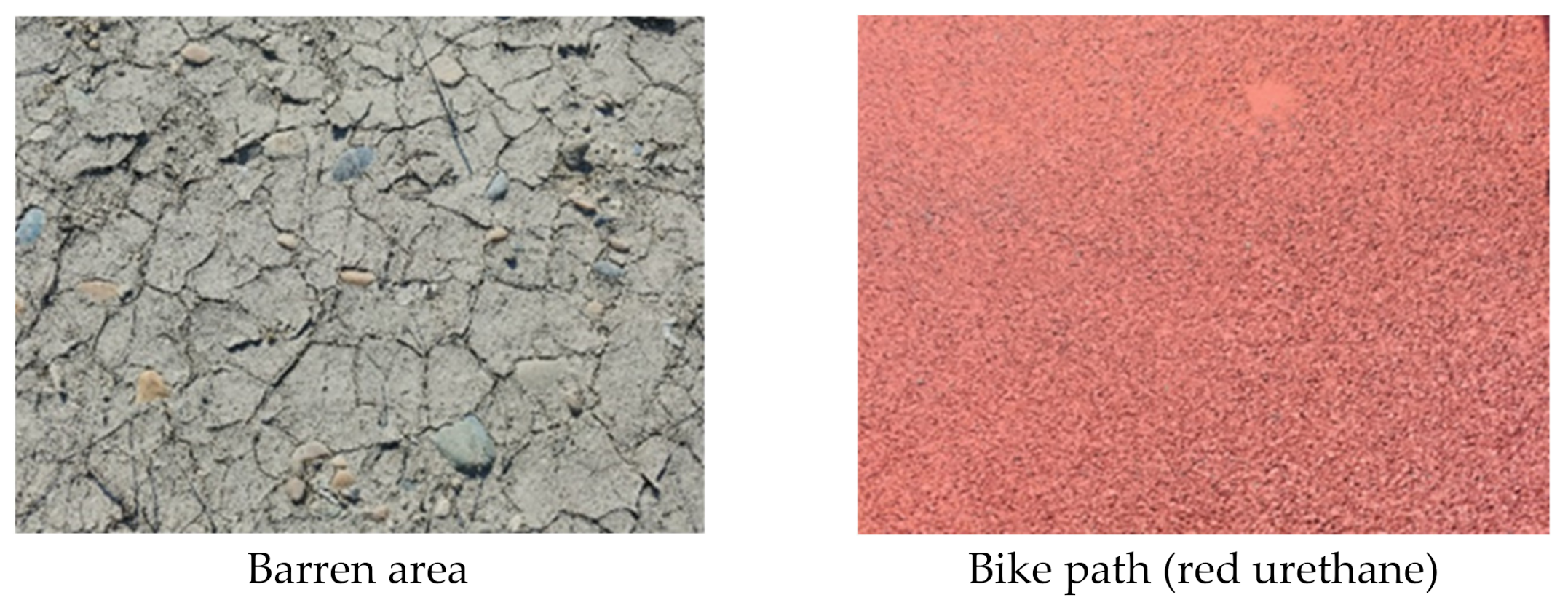
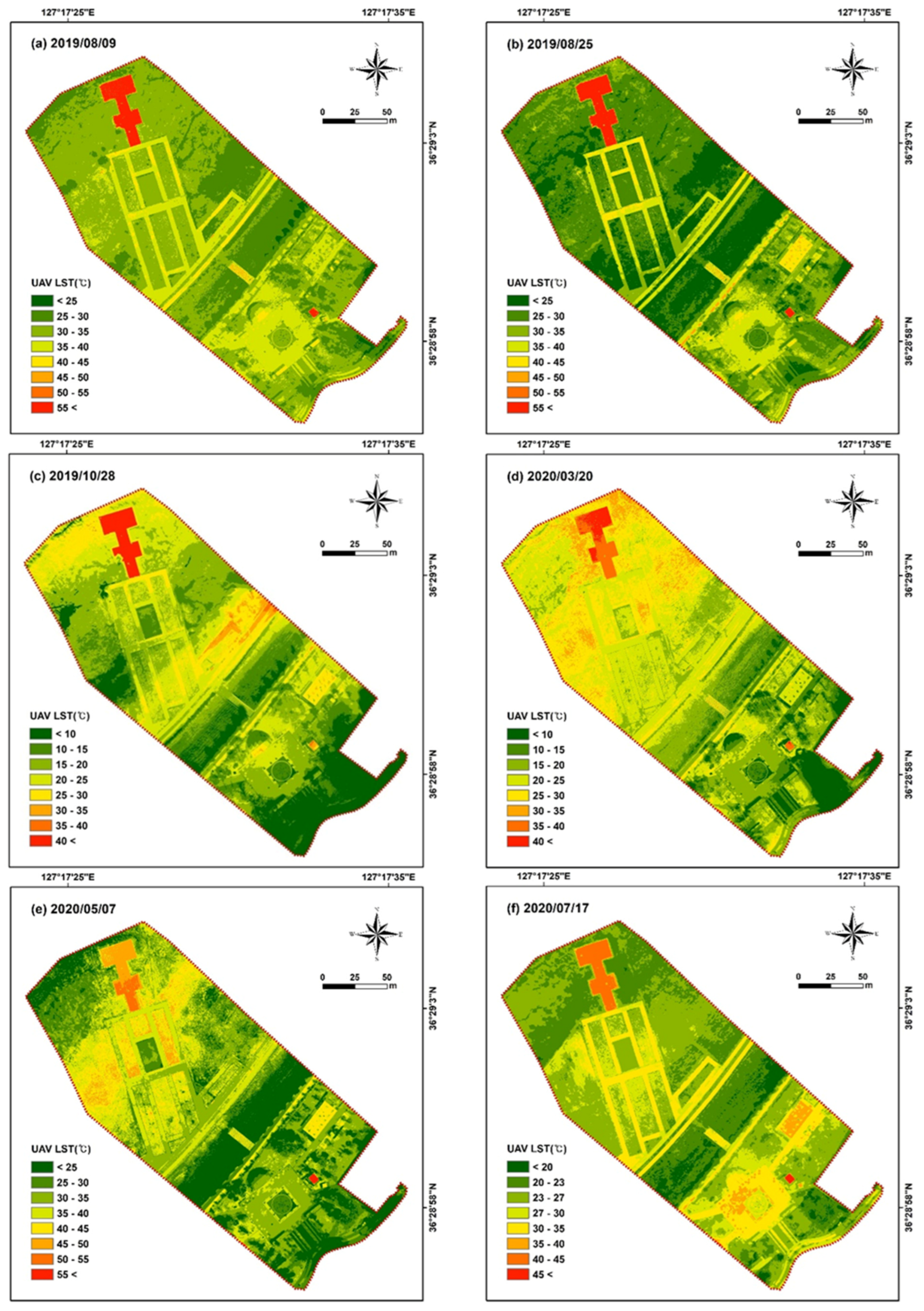
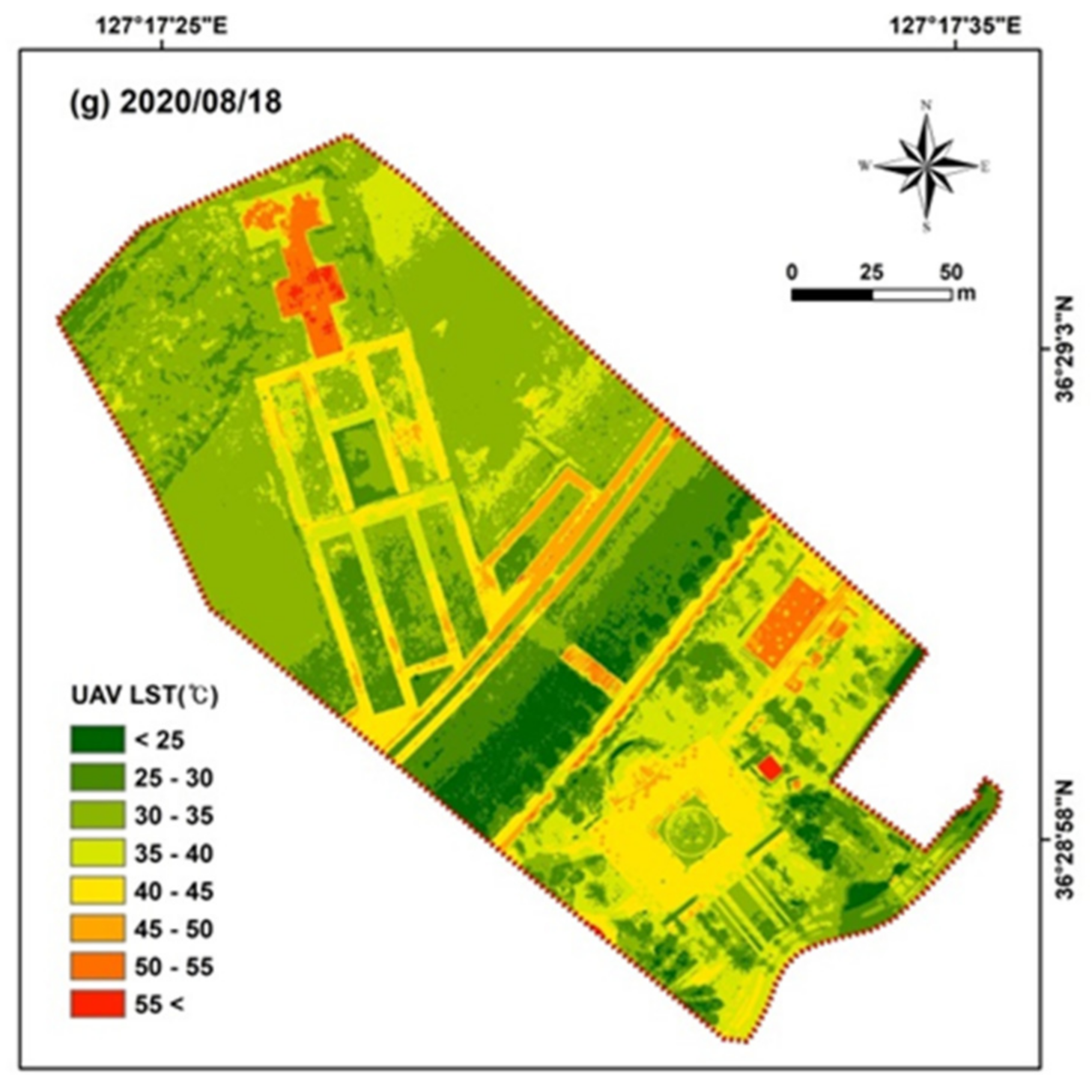
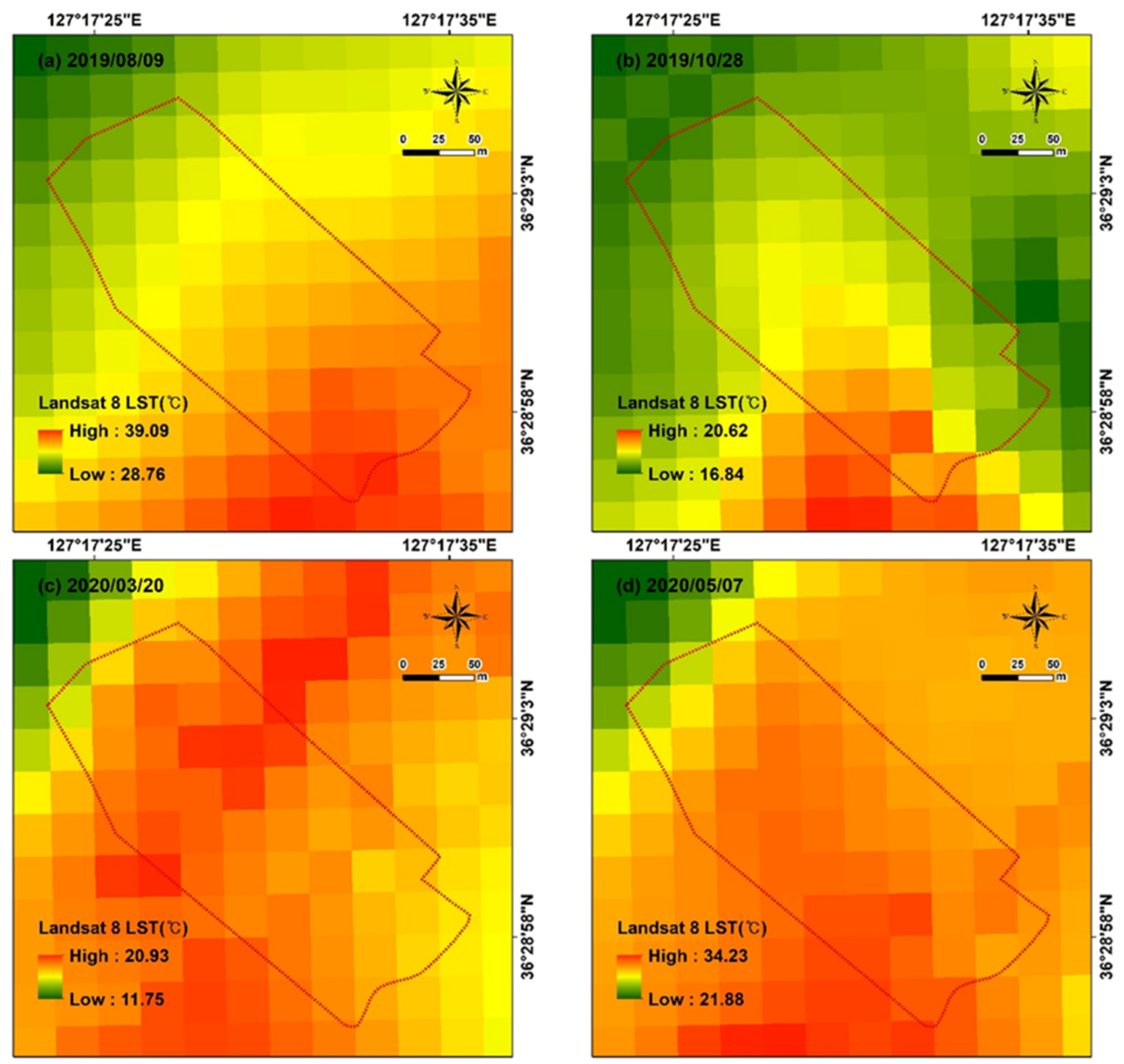


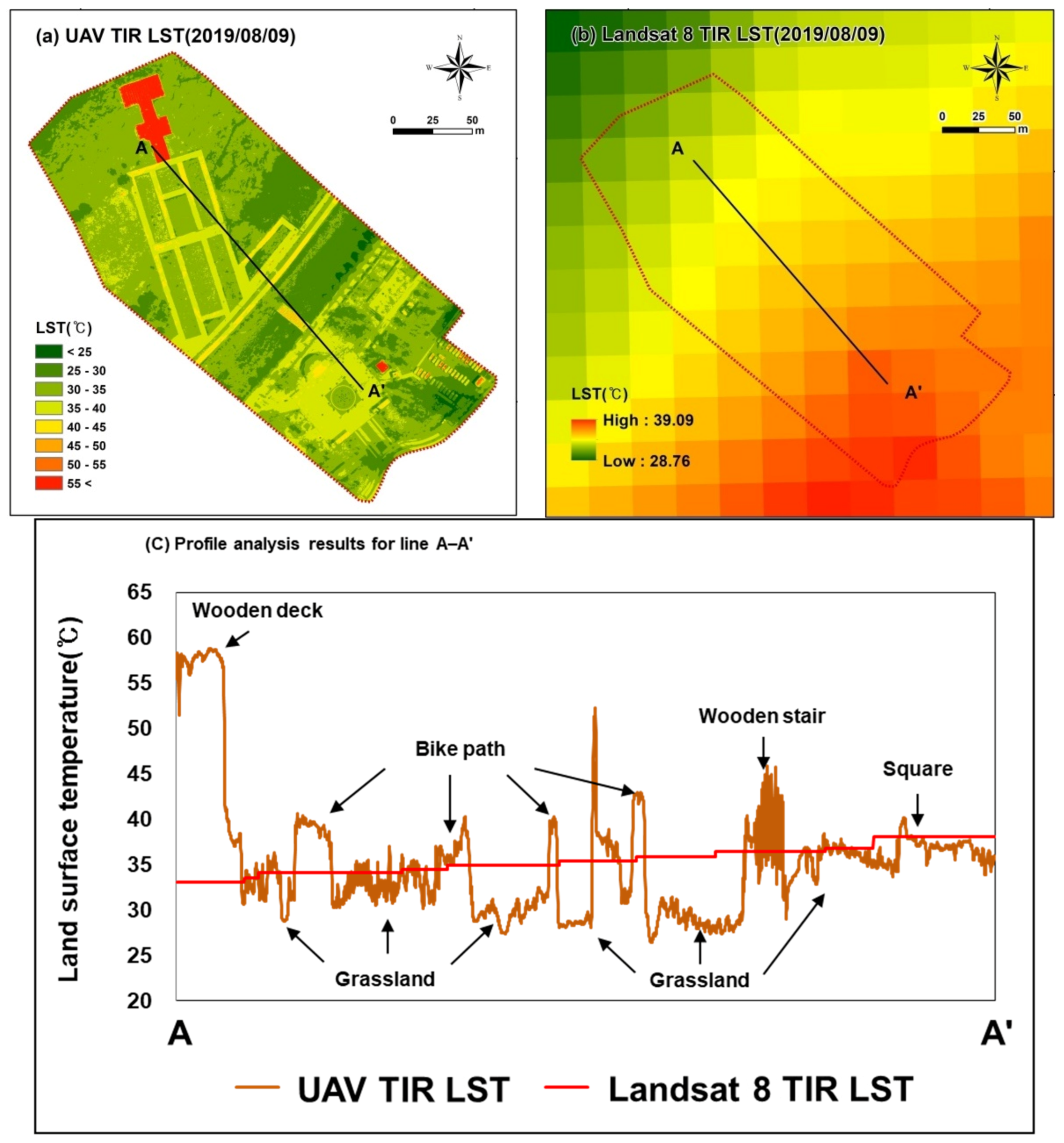
| Date | Time | Air Temp (°C) | Wind Speed (m/s) | Wind Direction (degrees) | Humidity (%) |
|---|---|---|---|---|---|
| 9 August 2019 | 11:00 a.m. | 30.8 | - | - | 73.9 |
| 9 August 2019 | 12:00 p.m. | 31.8 | 1.3 | 40.7 | 64.8 |
| 25 August 2019 | 11:00 a.m. | 26.8 | 1.1 | 338.2 | 57.3 |
| 25 August 2019 | 12:00 p.m. | 27.5 | 1.9 | 355.3 | 55.4 |
| 28 October 2019 | 11:00 a.m. | 15.3 | 2 | 85.3 | 49.1 |
| 28 October 2019 | 12:00 p.m. | 17.4 | 1.4 | 233.2 | 46.9 |
| 20 March 2020 | 11:00 a.m. | 12.8 | 3 | 222.9 | 31 |
| 20 March 2020 | 12:00 p.m. | 13.7 | 3 | 219.9 | 30.5 |
| 7 May 2020 | 11:00 a.m. | 22.9 | 3.4 | 80.5 | 24.3 |
| 7 May 2020 | 12:00 p.m. | 23.4 | 3.9 | 91.6 | 22.1 |
| 17 July 2020 | 11:00 a.m. | 26.8 | 1.4 | 84.1 | 68.6 |
| 17 July 2020 | 12:00 p.m. | 26.8 | 1.9 | 78 | 66.7 |
| 18 August 2020 | 11:00 a.m. | 31 | 1 | 245.6 | 64.4 |
| 18 August 2020 | 12:00 p.m. | 31.4 | 1.5 | 9.3 | 61.9 |
| Classification | Model | Specification |
|---|---|---|
| UAV | Inspire Pro 1 | Weight: 3.4 kg (including camera and battery) Max speed: 18 m/s Flight time: Approximately 18 min (18-m TB48 battery) Operating temperature: −10 to 40 °C |
| Camera | Zenmuse XTR | Dimensions: 103 mm × 74 mm × 102 mm Weight: 270 g Resolution: 640 × 512 pixel Pixel pitch: 17 μm Spectral range: 7.5–13.5 μm Scene range: −25° to 135 °C (high gain) Accuracy: ±5 °C Field of view: 13 mm, 45° × 37° Operating temperature: −10 to 40 °C |
| VRS-RTK GNSS | Trimble R8s GNSS | Channel: 440 Satellite: GPS, GLONASS VRS H: 8 mm + 0.5 ppm RMS VRS V: 15 mm + 0.5 ppm RMS |
| Date | Path/Row | Start Time | Stop Time |
|---|---|---|---|
| 9 August 2019 | 115/35 | 11:05:06 | 11:05:38 |
| 28 October 2019 | 115/35 | 11:05:24 | 11:05:55 |
| 20 March 2020 | 115/35 | 11:04:49 | 11:05:21 |
| 7 May 2020 | 115/35 | 11:04:24 | 11:04:56 |
| 18 August 2020 | 116/35 | 11:11:13 | 11:11:45 |
| Date | LST Data | Wooden Deck | Sports Facility (GU) | Bike Path (RU) | Bike Path (GC) | Bike Path (OU) | Square (GT) | Grassland | Barren Area |
|---|---|---|---|---|---|---|---|---|---|
| 9 August 2019 | UAV (Mean) | 58.23 | 36.85 | 37.9 | 32.91 | 38.54 | 38.41 | 33.03 | - |
| 25 August 2019 | UAV (Mean) | 56.84 | 42.2 | 36.2 | 33.85 | 31.54 | 37.88 | 28.18 | - |
| 28 October 2019 | UAV (Mean) | 41.67 | 27.63 | 21.43 | 12.81 | 20.03 | 20.1 | 17.82 | - |
| 20 March 2020 | UAV (Mean) | 39.65 | 21.74 | 23.97 | 13.52 | 21.65 | 18.88 | 20.38 | 26.37 |
| 7 May 2020 | UAV (Mean) | 49.9 | 40.2 | 38.64 | 28.25 | 34.5 | 34.35 | 30.07 | 39.0 |
| 17 July 2020 | UAV (Mean) | 41.0 | 35.05 | 33.77 | 29.62 | 30.4 | 34.7 | 25.22 | - |
| 18 August 2020 | UAV (Mean) | 50.32 | 50.69 | 48.78 | 37.66 | 41.54 | 43.07 | 32.29 | - |
| Total | UAV (Mean) | 48.23 | 36.34 | 34.39 | 26.95 | 31.17 | 32.49 | 26.82 | 32.69 |
| Date | LST Data | Wooden Deck | Sports Facility (GU) | Bike Path (RU) | Bike Path (GC) | Bike Path (OU) | Square (GT) | Grassland | Barren Area |
|---|---|---|---|---|---|---|---|---|---|
| 9 August 2019 | L8 (Mean) | 32.71 | 36.42 | 36.13 | 36.93 | 34.76 | 38.2 | 35.51 | - |
| 28 October 2019 | L8 (Mean) | 17.97 | 18.37 | 18.95 | 18.57 | 18.75 | 19.85 | 18.72 | - |
| 20 March 2020 | L8 (Mean) | 19.47 | 18.84 | 18.88 | 18.29 | 20.05 | 18.86 | 19.28 | 19.9 |
| 7 May 2020 | L8 (Mean) | 30.32 | 31.2 | 32.03 | 31.89 | 32.26 | 32.9 | 32.3 | 31.63 |
| 18 August 2020 | L8 (Mean) | 31.96 | 35.1 | 34.96 | 35.34 | 33.61 | 36.68 | 34.47 | - |
| Total | L8 (Mean) | 26.49 | 27.99 | 28.19 | 28.2 | 27.89 | 29.3 | 28.28 | 25.76 |
| Date | LST Data | Wooden Deck | Sports Facility (GU) | Bike Path (RU) | Bike Path (GC) | Bike Path (OU) | Square (GT) | Grassland | Barren Area |
|---|---|---|---|---|---|---|---|---|---|
| 9 August 2019 | In situ (Mean) | 53.83 | 38.53 | 40.69 | 35.3 | 39.65 | 39.2 | 34.38 | - |
| 9 August 2019 | In situ (SD) | 0.38 | 3.68 | 4.2 | 3.02 | 0.3 | 0.41 | 1.98 | - |
| 25 August 2019 | In situ (Mean) | 52.78 | 41.75 | 36.79 | 34.54 | 33.23 | 37.53 | 31.72 | - |
| 25 August 2019 | In situ (SD) | 1.18 | 2.8 | 4.02 | 3.76 | 2.98 | 1.28 | 1.62 | - |
| 28 October 2019 | In situ (Mean) | 36.05 | 24.6 | 24.74 | 18.71 | 24.48 | 23.78 | 20.57 | - |
| 28 October 2019 | In situ (SD) | 0.61 | 1.56 | 1.98 | 4.1 | 1.13 | 1.13 | 3.73 | - |
| 20 March 2020 | In situ (Mean) | 37.23 | 26.9 | 26.64 | 18.24 | 25.05 | 22.73 | 19.66 | 27.04 |
| 20 March 2020 | In situ (SD) | 0.83 | 0.56 | 0.71 | 4.43 | 1.7 | 0.98 | 1.75 | 3.56 |
| 7 May 2020 | In situ (Mean) | 45.23 | 38.75 | 37.47 | 31.4 | 34.35 | 35.1 | 31.17 | 38.54 |
| 7 May 2020 | In situ (SD) | 0.88 | 0.25 | 1.79 | 2.25 | 0.66 | 1.11 | 5.89 | 2.18 |
| 17 July 2020 | In situ (Mean) | 42.38 | 36.0 | 36.12 | 32.3 | 33.4 | 35.28 | 28.0 | - |
| 17 July 2020 | In situ (SD) | 0.03 | 0.06 | 1.69 | 1.48 | 0.06 | 0.03 | 0.82 | - |
| 18 August 2020 | In situ (Mean) | 48.08 | 50.85 | 49.97 | 39.7 | 43.63 | 43.63 | 34.16 | - |
| 18 August 2020 | In situ (SD) | 3.33 | 1.01 | 0.74 | 6.19 | 1.48 | 0.33 | 5.63 | - |
| In situ total | In situ (Mean) | 45.08 | 36.77 | 36.06 | 30.03 | 33.4 | 33.89 | 28.74 | 32.79 |
| In situ total | In situ (SD) | 6.66 | 8.47 | 8.28 | 8.63 | 6.66 | 7.29 | 6.63 | 6.47 |
| Compared LST Data | Date | Wooden Deck | Sports Facility (GU) | Bike Path (RU) | Bike Path (GC) | Bike Path (OU) | Square (GT) | Grassland | Barren | Total |
|---|---|---|---|---|---|---|---|---|---|---|
| UAV TIR LST | 9 August 2019 | 4.4 | −1.68 | −2.79 | −2.39 | −1.11 | −0.79 | −1.35 | −1.29 | |
| 25 August 2019 | 4.06 | 0.45 | −0.59 | −0.69 | −1.69 | 0.35 | −3.54 | −1.52 | ||
| 28 October 2019 | 5.62 | 3.03 | −3.31 | −5.9 | −4.45 | −3.68 | −2.75 | −2.67 | ||
| 20 March 2020 | 2.42 | −5.16 | −2.67 | −4.72 | −3.4 | −3.85 | 0.72 | −0.67 | −1.7 | |
| 7 May 2020 | 4.67 | 1.45 | 1.17 | −3.15 | 0.15 | −0.75 | −1.1 | 0.46 | −0.46 | |
| 17 July 2020 | −1.38 | −0.95 | −2.35 | −2.68 | −3 | −0.58 | −2.78 | −2.37 | ||
| 18 August 2020 | 2.24 | −0.16 | −1.19 | −2.04 | −2.09 | −0.56 | −1.87 | −1.37 | ||
| Total | 3.15 | −0.43 | −1.67 | −3.08 | −2.23 | −1.4 | −1.92 | −0.1 | −1.63 | |
| L8 TIR LST | 25 August 2019 | −21.12 | −2.11 | −4.56 | 1.63 | −4.89 | −1 | 1.13 | −1.58 | |
| 28 October 2019 | −18.08 | −6.23 | −5.79 | −0.14 | −5.73 | −3.93 | −1.85 | −3.67 | ||
| 20 March 2020 | −17.76 | −8.06 | −7.76 | 0.05 | −5 | −3.87 | −0.38 | −7.14 | −3.92 | |
| 7 May 2020 | −14.91 | −7.55 | −5.44 | 0.49 | −2.09 | −2.2 | 1.13 | −6.91 | −2.55 | |
| 18 August 2020 | −16.12 | −15.75 | −15.01 | −4.36 | −10.02 | −6.95 | 0.31 | −5.49 | ||
| Total | −18.59 | −8.78 | −7.87 | −1.83 | −5.51 | −4.59 | −0.46 | −7.03 | −4.07 |
| Time | LST Data | Wooden Deck | Sports Facility (GU) | Bike Path (RU) | Bike Path (GC) | Bike Path (OU) | Square (GT) | Grassland | Barren Area | Total |
|---|---|---|---|---|---|---|---|---|---|---|
| 9 August 2019 | UAV (RMSE) | 4.399 | 2.628 | 2.951 | 2.651 | 1.112 | 1.105 | 2.241 | - | 2.523 |
| L8 (RMSE) | 21.131 | 4.238 | 6.344 | 3.8 | 4.907 | 1.148 | 2.499 | - | 6.502 | |
| 25 August 2019 | UAV (RMSE) | 4.106 | 2.148 | 2.821 | 1.457 | 2.461 | 1.066 | 4.586 | - | 3.499 |
| L8 (RMSE) | - | - | - | - | - | - | - | - | - | |
| 28 October 2019 | UAV (RMSE) | 5.63 | 3.603 | 3.931 | 8.396 | 5.091 | 3.718 | 3.96 | - | 5.298 |
| L8 (RMSE) | 18.1 | 6.329 | 6.241 | 3.898 | 5.88 | 4.23 | 4.409 | - | 6.585 | |
| 20 March 2020 | UAV (RMSE) | 3.066 | 5.164 | 3.205 | 5.403 | 3.824 | 3.976 | 1.506 | 5.141 | 3.834 |
| L8 (RMSE) | 17.768 | 8.085 | 7.807 | 3.681 | 5.134 | 3.995 | 1.743 | 7.775 | 6.64 | |
| 7 May 2020 | UAV (RMSE) | 4.695 | 1.681 | 2.195 | 3.587 | 1.638 | 0.993 | 2.509 | 3.26 | 2.849 |
| L8 (RMSE) | 14.91 | 7.559 | 5.678 | 2.444 | 1.882 | 2.341 | 5.966 | 7.251 | 6.385 | |
| 17 July 2020 | UAV (RMSE) | 1.381 | 1.031 | 3.107 | 2.985 | 3.011 | 0.576 | 3.401 | - | 2.93 |
| L8 (RMSE) | - | - | - | - | - | - | - | - | - | |
| 18 August 2020 | UAV (RMSE) | 2.246 | 1.997 | 1.241 | 2.707 | 2.124 | 0.713 | 3.469 | - | 2.788 |
| L8 (RMSE) | 16.386 | 15.786 | 15.012 | 7.628 | 10.068 | 6.964 | 5.548 | - | 9.593 | |
| Total | UAV (RMSE) | 3.897 | 2.904 | 2.889 | 4.439 | 3.026 | 2.198 | 3.316 | 4.304 | 3.502 |
| L8 (RMSE) | 15.027 | 7.835 | 8.919 | 4.633 | 6.163 | 4.223 | 4.358 | 7.518 | 7.246 |
Publisher’s Note: MDPI stays neutral with regard to jurisdictional claims in published maps and institutional affiliations. |
© 2021 by the authors. Licensee MDPI, Basel, Switzerland. This article is an open access article distributed under the terms and conditions of the Creative Commons Attribution (CC BY) license (https://creativecommons.org/licenses/by/4.0/).
Share and Cite
Kim, D.; Yu, J.; Yoon, J.; Jeon, S.; Son, S. Comparison of Accuracy of Surface Temperature Images from Unmanned Aerial Vehicle and Satellite for Precise Thermal Environment Monitoring of Urban Parks Using In Situ Data. Remote Sens. 2021, 13, 1977. https://doi.org/10.3390/rs13101977
Kim D, Yu J, Yoon J, Jeon S, Son S. Comparison of Accuracy of Surface Temperature Images from Unmanned Aerial Vehicle and Satellite for Precise Thermal Environment Monitoring of Urban Parks Using In Situ Data. Remote Sensing. 2021; 13(10):1977. https://doi.org/10.3390/rs13101977
Chicago/Turabian StyleKim, Dongwoo, Jaejin Yu, Jeongho Yoon, Seongwoo Jeon, and Seungwoo Son. 2021. "Comparison of Accuracy of Surface Temperature Images from Unmanned Aerial Vehicle and Satellite for Precise Thermal Environment Monitoring of Urban Parks Using In Situ Data" Remote Sensing 13, no. 10: 1977. https://doi.org/10.3390/rs13101977
APA StyleKim, D., Yu, J., Yoon, J., Jeon, S., & Son, S. (2021). Comparison of Accuracy of Surface Temperature Images from Unmanned Aerial Vehicle and Satellite for Precise Thermal Environment Monitoring of Urban Parks Using In Situ Data. Remote Sensing, 13(10), 1977. https://doi.org/10.3390/rs13101977







